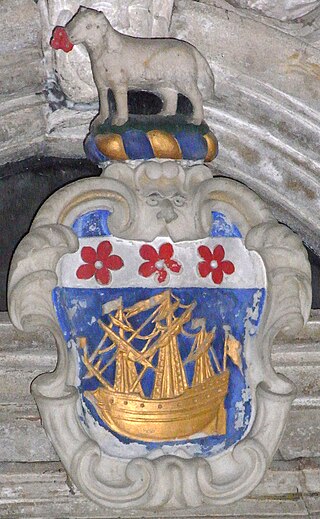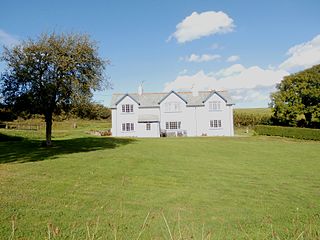Related Research Articles
Buckland may refer to:

Braunton is a large village, civil parish, ecclesiastical parish and former manor in Devon. The village is situated 5 miles (8 km) west of Barnstaple. It is one of the largest villages in Devon with a population at the 2021 census of 10,217 people. There are two electoral wards. Their joint population at the above census was 8,218. Within the parish is the fertile, low-lying Braunton Great Field, which adjoins the undulating Braunton Burrows, the Core Area in North Devon Biosphere Reserve, the largest psammosere in England. It confronts the Atlantic Ocean at the west of the parish at the large beach of Saunton Sands, one of the South West's international-standard surfing beaches.

Pilton is a suburb of the town of Barnstaple, it is located about quarter of a mile north of the town centre, in the civil parish of Barnstaple, in the North Devon district, in the county of Devon, England. It was formerly a separate village. The civil parish of Pilton West covers the more rural parts of the ancient parish of Pilton that have not been incorporated into the town of Barnstaple. In 2009, the Pilton (Barnstaple) ward had a population of 4,239 living in some 1,959 dwellings. It has its own infants and junior school, houses one of Barnstaple's larger secondary schools, and one of Barnstaple's SEN specialist schools. North Devon Hospital is also within West Pilton parish. It has a Church Hall, two public houses, two hotels, and residential homes. It has residential estates of both private and public housing including flats. It also has a historic Church that dates back to at least the 11th Century.

Braunton Burrows is a sand dune system on the North Devon coast. It is privately owned and forms part of the Christie Devon Estates Trust. Braunton Burrows is a prime British sand dune site, the largest sand dune system (psammosere) in England. It is particularly important ecologically because it includes the complete successional range of dune plant communities, with over 470 vascular plant species. The short turf communities are very rich in lichens and herbs, and the dune slacks are also rich. The many rare plants and animals include 14 with UK Biodiversity Action Plans. For example, this is one of only two sites in the UK for the Amber Sandbowl Snail Catinella arenaria, which is found on the wet dune slacks.

Heanton Punchardon ( ) is a village, civil parish and former manor, anciently part of Braunton Hundred. It is situated directly east-southeast of the village of Braunton, in North Devon. The parish lies on the north bank of the estuary of the River Taw and it is surrounded, clockwise from the north, by the parishes of Braunton, Marwood, Ashford and across the estuary, Fremington. The population was 418 in 1801 and 404 in 1901. Its largest localities are Wrafton and Chivenor. The surrounding area is also an electoral ward with a total population at the 2011 census of 2,673.
Apart from a number of places in Devon, England, for which Buckland forms the first part of the name, the name on its own refers to two places in Devon:

Bideford Bay, also known as Barnstaple Bay and often shown on maps as Barnstaple or Bideford Bay, is a large area of water on the northwest coast of Devon in South West England, at the southwestern end of the Bristol Channel where it joins the Celtic Sea. The bay extends from Hartland Point in the southwest to Baggy point the northeast, and is partly sheltered by the island of Lundy, 12 miles (19 km) offshore. It takes its alternative names from the towns of Bideford and Barnstaple, located respectively on the rivers Torridge and Taw which flow into the bay. The alternative spelling Barnstable Bay, in use long after that spelling became obsolete for the town, is also sometimes seen.

John Davie (1640–1710) of Orleigh Court in the parish of Buckland Brewer, Devon, England, was a prominent tobacco merchant from Bideford, Devon. His Bideford town house which he built in 1688, was Colonial House, now the Royal Hotel, in which survive several 17th-century decorative plasterwork ceilings, said by Pevsner & Cherry (2004) to be amongst the best in Devon, and a grand staircase.

Colleton is a hamlet and former manor in the civil parish and ecclesiastical parish of Chulmleigh, in the North Devon district of Devon, England. It is situated on the north side of a valley containing the River Taw. Its nearest town is Chulmleigh, which lies approximately 3.6 miles (5.8 km) to the south-west. It consists of the grade I listed Colleton Barton and Colleton Mill, the former manorial mill, with another former industrial building situated at the approach to the bridge over the River Taw.
William de Falaise, also called William of Falaise, was a Norman from Falaise, Duchy of Normandy, today in the Calvados department in the Lower Normandy region of north-western France. He became feudal baron of Stogursey in Somerset and also held manors in Devon.
East Hagginton was a historic estate within the manor and parish of Berrynarbor near to the coast of North Devon. It is near to, if not actually encompassing, the site of Watermouth Castle.

Incledon in the parish of Braunton, North Devon, England, is an ancient historic estate which gave its name to the locally prominent de Incledon family, first recorded in 1160. It is situated one mile north-west of St Brannock's Church in Braunton. Its relationship to Incledon Hill in the parish of Georgeham, where is situated a modern farmhouse also called Incledon, 1 1/4 miles north-west of Incledon in Braunton, is unclear. In 1319 the Incledon family purchased the adjoining estate of Buckland, and the present Georgian Buckland House, 1/2 mile south-east of Incledon, is still occupied in 2014 by descendants of the Incledon-Webber family.

Buckland in the parish of Braunton, North Devon, England, is an ancient historic estate purchased in 1319 by Godfrey II de Incledene of Incledon, the adjoining estate about 1/2 mile to the north-west, whose family, is first recorded in 1160. It is situated half a mile north-west of St Brannock's Church in Braunton. Buckland House, a grade II* listed mansion remodelled in the 18th century, is still occupied in 2014 by descendants of the Incledon-Webber family, formerly prominent in the political and commercial life of nearby Barnstaple and North Devon. The owner of the estate in 1937, William Beare Incledon-Webber was also lord of the manor of nearby Croyde and Putsborough.

Robert Incledon (1676–1758) of Pilton House, Pilton, near Barnstaple in North Devon, was a lawyer of New Inn, London, a Clerk of the Peace for Devon, Deputy Recorder of Barnstaple and was twice Mayor of Barnstaple, in 1712 and 1721. In 1713 as mayor he supervised the building of the Mercantile Exchange on Barnstaple Quay, as recorded on the building by a contemporary brass plaque and sculpture of his armorials. He built Pilton House in 1746.
The 2016–17 South West Peninsula League season was the tenth in the history of the South West Peninsula League, a football competition in England, that feeds the Premier Division of the Western Football League. The league had been formed in 2007 from the merger of the Devon County League and the South Western League, and is restricted to clubs based in Cornwall and Devon. The Premier Division of the South West Peninsula League is on the same level of the National League System as the Western League Division One.
The Manor of Heanton Punchardon was a manor in the parish of Heanton Punchardon, Devon, England.
References
- 1 2 "THE HUNDREDS OF DEVON". GENUKI. Retrieved 8 April 2018.